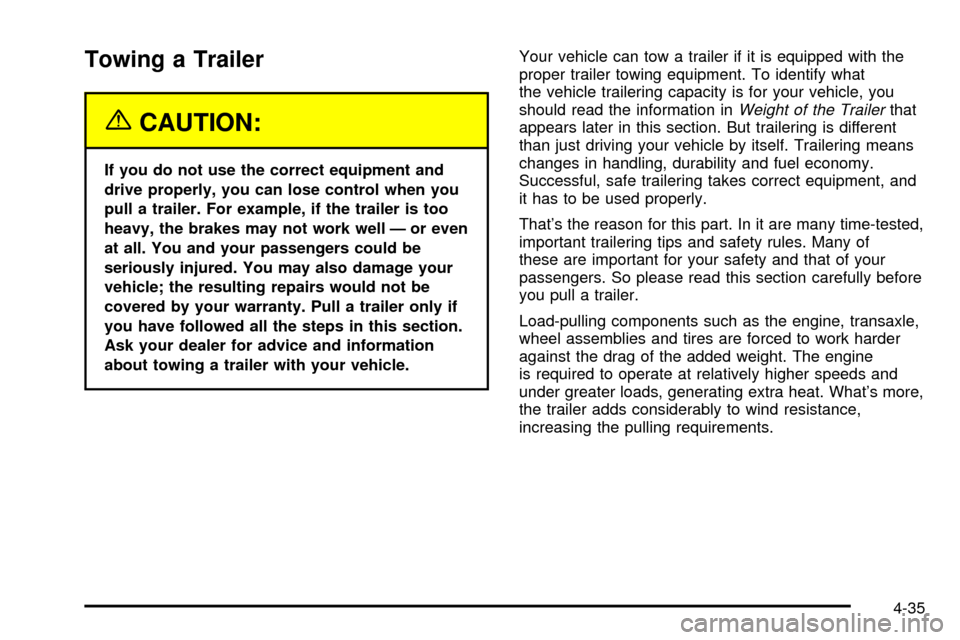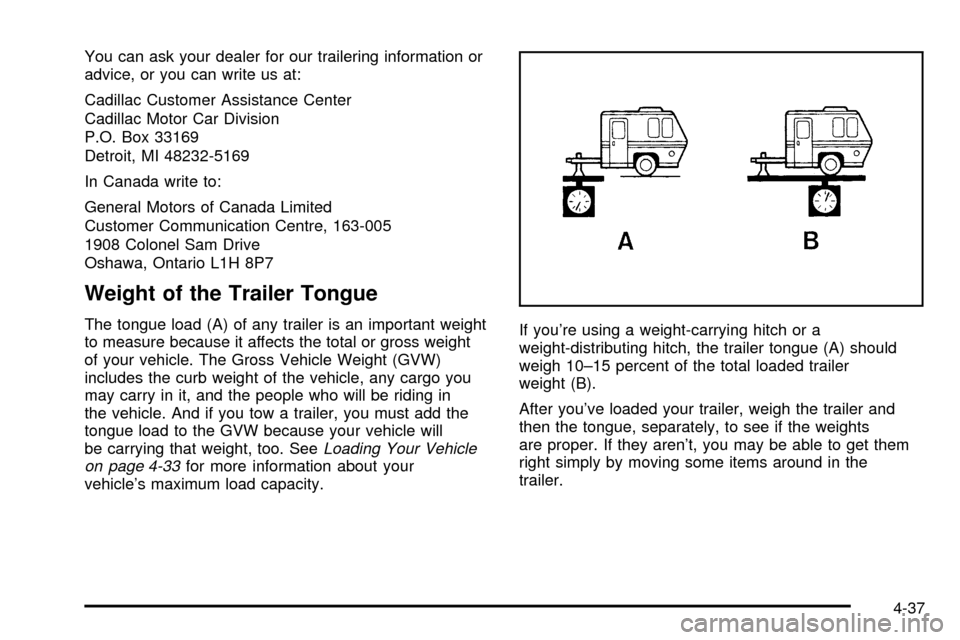2003 CADILLAC SEVILLE weight
[x] Cancel search: weightPage 253 of 408

Towing a Trailer
{CAUTION:
If you do not use the correct equipment and
drive properly, you can lose control when you
pull a trailer. For example, if the trailer is too
heavy, the brakes may not work well Ð or even
at all. You and your passengers could be
seriously injured. You may also damage your
vehicle; the resulting repairs would not be
covered by your warranty. Pull a trailer only if
you have followed all the steps in this section.
Ask your dealer for advice and information
about towing a trailer with your vehicle.Your vehicle can tow a trailer if it is equipped with the
proper trailer towing equipment. To identify what
the vehicle trailering capacity is for your vehicle, you
should read the information in
Weight of the Trailerthat
appears later in this section. But trailering is different
than just driving your vehicle by itself. Trailering means
changes in handling, durability and fuel economy.
Successful, safe trailering takes correct equipment, and
it has to be used properly.
That's the reason for this part. In it are many time-tested,
important trailering tips and safety rules. Many of
these are important for your safety and that of your
passengers. So please read this section carefully before
you pull a trailer.
Load-pulling components such as the engine, transaxle,
wheel assemblies and tires are forced to work harder
against the drag of the added weight. The engine
is required to operate at relatively higher speeds and
under greater loads, generating extra heat. What's more,
the trailer adds considerably to wind resistance,
increasing the pulling requirements.
4-35
Page 254 of 408

If You Do Decide To Pull A Trailer
If you do, here are some important points:
·There are many different laws, including speed limit
restrictions, having to do with trailering. Make sure
your rig will be legal, not only where you live
but also where you'll be driving. A good source for
this information can be state or provincial police.
·Consider using a sway control if your trailer will
weigh 2,000 lbs (900 kg) or less. You should
always use a sway control if your trailer will weigh
more than 2,000 lbs (900 kg). You can ask a
hitch dealer about sway controls.
·Don't tow a trailer at all during the ®rst 1,000 miles
(1 600 km) your new vehicle is driven. Your
engine, axle or other parts could be damaged.
·Then, during the ®rst 500 miles (800 km) that you
tow a trailer, don't drive over 50 mph (80 km/h)
and don't make starts at full throttle. This helps your
engine and other parts of your vehicle wear in at
the heavier loads.
·Obey speed limit restrictions when towing a trailer.
Don't drive faster than the maximum posted speed
for trailers, or no more than 55 mph (90 km/h),
to save wear on your vehicle's parts.Three important considerations have to do with weight:
·the weight of the trailer,
·the weight of the trailer tongue
·and the total weight on your vehicle's tires.
Weight of the Trailer
How heavy can a trailer safely be?
It depends on how you plan to use your rig. For
example, speed, altitude, road grades, outside
temperature and how much your vehicle is used to pull
a trailer are all important. And, it can also depend
on any special equipment that you have on your vehicle.
It should never weigh more than 2,000 lbs (900 kg) if
you have an SLS model. If you have an STS model, the
maximum trailer weight should never be more than
3,000 lbs (1 350 kg). These are total maximum weights
including the load. But even that can be too heavy.
The maximum trailer weight for your vehicle can be
determined from the Gross Combined Vehicle Weight
(GCVW). The GCVW = curb weight + passenger's weight
+ cargo weight + trailer weight. The GCVW should never
be more than 7,100 lbs (3 223 kg) total loaded vehicle
and trailer for SLS models and 8,100 lbs (3 677 kg) total
loaded vehicle and trailer for STS models.
4-36
Page 255 of 408

You can ask your dealer for our trailering information or
advice, or you can write us at:
Cadillac Customer Assistance Center
Cadillac Motor Car Division
P.O. Box 33169
Detroit, MI 48232-5169
In Canada write to:
General Motors of Canada Limited
Customer Communication Centre, 163-005
1908 Colonel Sam Drive
Oshawa, Ontario L1H 8P7
Weight of the Trailer Tongue
The tongue load (A) of any trailer is an important weight
to measure because it affects the total or gross weight
of your vehicle. The Gross Vehicle Weight (GVW)
includes the curb weight of the vehicle, any cargo you
may carry in it, and the people who will be riding in
the vehicle. And if you tow a trailer, you must add the
tongue load to the GVW because your vehicle will
be carrying that weight, too. See
Loading Your Vehicle
on page 4-33for more information about your
vehicle's maximum load capacity.If you're using a weight-carrying hitch or a
weight-distributing hitch, the trailer tongue (A) should
weigh 10±15 percent of the total loaded trailer
weight (B).
After you've loaded your trailer, weigh the trailer and
then the tongue, separately, to see if the weights
are proper. If they aren't, you may be able to get them
right simply by moving some items around in the
trailer.
4-37
Page 256 of 408

Total Weight on Your Vehicle's Tires
Be sure your vehicle's tires are in¯ated to the upper limit
for cold tires. You'll ®nd these numbers on the
Tire-Loading Information label at the rear edge of the
driver's door or see
Loading Your Vehicle on page 4-33.
Then be sure you don't go over the GVW limit for
your vehicle, including the weight of the trailer tongue.
Hitches
It's important to have the correct hitch equipment.
Crosswinds, large trucks going by and rough roads are
a few reasons why you'll need the right hitch. Here
are some rules to follow:
·The rear bumper on your vehicle is not intended for
hitches. Do not attach rental hitches or other
bumper-type hitches to it. Use only a
frame-mounted hitch that does not attach to
the bumper.
·If you'll be pulling a trailer that, when loaded, will
weigh more than 2,000 lbs (900 kg), be sure to
use a properly mounted, weight-distributing
hitch and sway control of the proper size. This
equipment is very important for proper vehicle
loading and good handling when you're driving.
·Will you have to make any holes in the body of
your vehicle when you install a trailer hitch? If
you do, then be sure to seal the holes later when
you remove the hitch. If you don't seal them, deadly
carbon monoxide (CO) from your exhaust can get
into your vehicle. See
Engine Exhaust on
page 2-35. Dirt and water can, too.
Safety Chains
You should always attach chains between your vehicle
and your trailer. Cross the safety chains under the
tongue of the trailer so that the tongue will not drop to
the road if it becomes separated from the hitch.
Instructions about safety chains may be provided by the
hitch manufacturer or by the trailer manufacturer.
Follow the manufacturer's recommendation for attaching
safety chains and do not attach them to the bumper.
Always leave just enough slack so you can turn
with your rig. And, never allow safety chains to drag on
the ground.
4-38
Page 257 of 408

Trailer Brakes
Because you have anti-lock brakes, don't try to tap into
your vehicle's hydraulic brake system. If you do,
both brake systems won't work well, or at all. If you tow
more than 1,000 lbs (450 kg), use trailer brakes. Be
sure to follow the instructions that come with the trailer
or from the brake manufacturer.
Be sure to read and follow the instructions for the trailer
brakes so you'll be able to install, adjust and maintain
them properly. Be sure to read and follow the
instructions for the trailer brakes so you'll be able to
install, adjust and maintain them properly.
Driving with a Trailer
Towing a trailer requires a certain amount of experience.
Before setting out for the open road, you'll want to get
to know your rig. Acquaint yourself with the feel of
handling and braking with the added weight of the trailer.
And always keep in mind that the vehicle you are
driving is now a good deal longer and not nearly as
responsive as your vehicle is by itself.Before you start, check the trailer hitch and platform
(and attachments), safety chains, electrical connector,
lamps, tires and mirror adjustment. If the trailer has
electric brakes, start your vehicle and trailer moving and
then apply the trailer brake controller by hand to be
sure the brakes are working. This lets you check your
electrical connection at the same time.
During your trip, check occasionally to be sure that the
load is secure, and that the lamps and any trailer
brakes are still working.
Following Distance
Stay at least twice as far behind the vehicle ahead as
you would when driving your vehicle without a trailer.
This can help you avoid situations that require
heavy braking and sudden turns.
Passing
You'll need more passing distance up ahead when
you're towing a trailer. And, because you're a good deal
longer, you'll need to go much farther beyond the
passed vehicle before you can return to your lane.
4-39
Page 406 of 408

Steering Wheel Controls, Memory.....................2-51
Steering........................................................4-11
Storage Areas................................................2-48
Cellular Telephone.......................................2-48
Center Console Storage Area........................2-49
Convenience Net.........................................2-49
Glove Box..................................................2-48
Map Pocket................................................2-49
Umbrella Holder..........................................2-49
Storage.........................................................2-49
Garment Hooks...........................................2-49
Storing the Flat Tire and Tools..........................5-81
Storing the Spare Tire and Tools.......................5-82
Stuck in Sand, Mud, Ice or Snow......................4-30
Sun Visors.....................................................2-18
Sunroof.........................................................2-50
Supplemental In¯atable Restraints (SIR).............1-44
How Does an Air Bag Restrain?....................1-50
Servicing Your Air Bag-Equipped Vehicle.........1-52
What Makes an Air Bag In¯ate?....................1-49
What Will You See After an Air Bag In¯ates?....1-50
When Should an Air Bag In¯ate?...................1-49
Where Are the Air Bags?..............................1-46
T
Tachometer....................................................3-41
Taillamps.......................................................5-60
Turn Signal Lamps......................................5-60Taillamps (cont.)
TCS Warning Light..........................................3-45
Testing the Alarm............................................2-20
Theft-Deterrent, Radio....................................3-102
Theft-Deterrent Systems...................................2-19
PASS-Key
žIII Operation..............................2-21
PASS-KeyžIII .............................................2-21
Throttle System Inspection...............................6-14
Tilt Wheel........................................................ 3-7
Tire In¯ation Check........................................... 6-9
Tire Pressure Display......................................3-75
Tires.............................................................5-63
Buying New Tires........................................5-68
Chains.......................................................5-72
Changing a Flat Tire....................................5-74
Compact Spare Tire.....................................5-83
If a Tire Goes Flat.......................................5-73
In¯ation -- Tire Pressure...............................5-64
Inspection and Rotation................................5-67
Pressure Monitor System..............................5-65
Uniform Tire Quality Grading.........................5-69
Wheel Alignment and Tire Balance.................5-71
Wheel Replacement.....................................5-71
When It Is Time for New Tires......................5-68
To Use the Engine Coolant Heater....................2-27
Top Strap Anchor Location...............................1-35
Top Strap......................................................1-33
Torque Lock...................................................2-34
Total Weight on Your Vehicle's Tires..................4-38
14
Page 408 of 408

W
Warning Lights, Gages and Indicators................3-37
Warnings.......................................................3-56
DIC Warnings and Messages........................3-56
Hazard Warning Flashers............................... 3-6
Other Warning Devices.................................. 3-7
Safety and Symbols......................................... iii
Vehicle Damage.............................................. iv
Washing Your Vehicle......................................5-86
Weather Band..............................................3-104
Weatherstrip Lubrication...................................6-10
Weight of the Trailer Tongue.............................4-37
Weight of the Trailer........................................4-36
What Kind of Engine Oil to Use........................5-16
What to Do with Used Oil................................5-18
What to Use..................................5-26, 5-38, 5-39
Wheels..........................................................5-71
Alignment and Tire Balance..........................5-71
Replacement...............................................5-71
When to Add Engine Oil..................................5-15
When to Change Engine Oil (GM Oil Life
System).....................................................5-17
When to Check and Change............................5-21
When to Check Power Steering Fluid................5-38
When to Check..............................................5-65
When You Are Ready to Leave After Parking
on a Hill:....................................................4-42Where to Put the Restraint...............................1-33
Why Safety Belts Work..................................... 1-7
Window Lockout.............................................2-18
Windows.......................................................2-15
Power........................................................2-16
Windshield Washer Fluid Level Check................. 6-9
Windshield Washer.........................................3-12
Fluid..........................................................5-39
Windshield Wiper............................................5-62
Blade Replacement......................................5-62
Fuses........................................................5-92
Windshield Wipers..........................................3-10
Winter Driving................................................4-26
Wiper Blade Check.........................................6-10
Wiper-Activated Headlamps..............................3-17
X
XMŸ Radio Satellite Service
(USA Only).........................................3-79, 3-88
XMŸ Satellite Radio Antenna System..............3-106
XMŸ Satellite Radio Service
(USA Only)...............................................3-103
Y
Your Vehicle and the Environment....................... 6-2
16